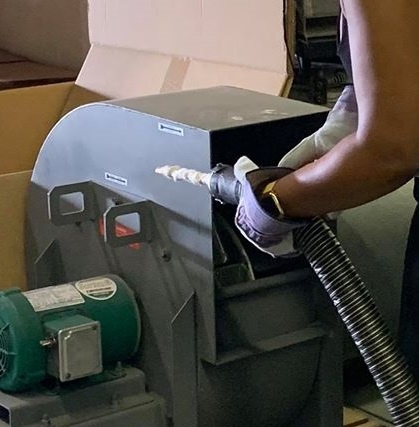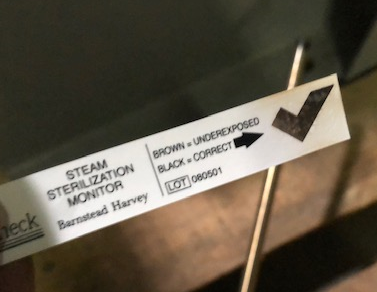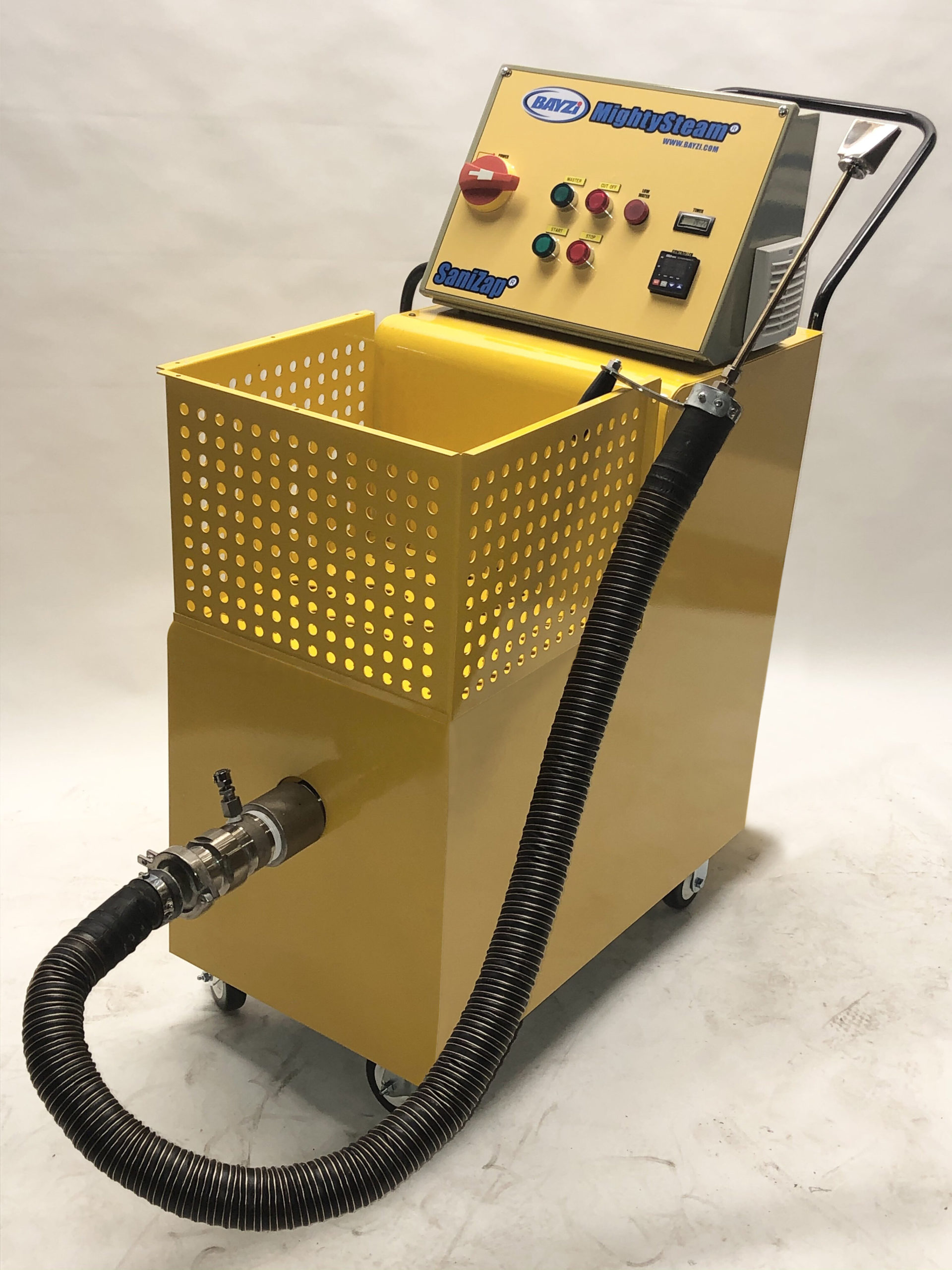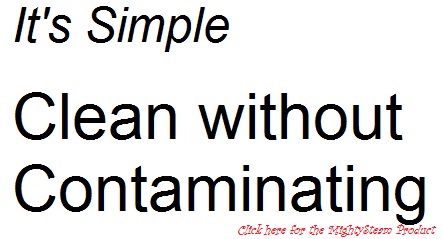Steam Sanitation and Decontamination
All of our masks could probably benefit from SaniZapping.
Masks accumulate millions of bacteria. Several sturdies are available by a web search. Not all bacteria are harmful but some could be.
Sterilization vs Disinfection vs Sanitization.
Sanitation within the food industry means the adequate treatment of food-contact surfaces by a process that is effective in destroying vegetative cells of microorganisms of public health significance, and in substantially reducing numbers of other undesirable microorganisms, but without adversely affecting the food or its safety for the consumer. We discuss below a few technical terms. See also The history of Sanitation and Hygiene..
Why use steam:
- Self drying steam leaves no mess or puddle.
- The optimal surface disinfectant for the most demanding hospital environment would have these qualities: Easy to use, quick disinfection, broad kill range, reduce potential of cross-contamination, non-toxic and will not damage surfaces.
- Since the active agent is not a biocidal or toxic chemical (just H2O is the active ingredient) disinfection is exceedingly fast and broad-spectrum. There is no chance of introducing chemical cross-resistance to antibiotics. Surfaces do not become sticky, no stain, or discoloration over time.
- Staff can disinfect as frequently as necessary without long-term chemical exposure concerns.
- The steam cleaning tool is hot, so the potential for cross-contamination from surface to surface or room to room is greatly reduced. This is in sharp-contrast to a fog, spray and wipe approach, which could possibly spread pathogens if the disinfectant is overused or inactivated for any reason including staleness.
- By using proper steam (200°C) any high-touch surfaces can be disinfected on an hourly basis without damage to the surface. Prevents chemical induced irritation to sensitive populations or long-term risks to customers or staff.
- One has to consider steam sanitizing from an objective, scientific perspective: It is a new technology with the potential to reduce pathogen transmission within your facility.
- As steam inactivates microbes very rapidly (seconds with steam compared to minutes for many chemicals), steam is considered a high productivity method.
The SaniZap® steam technology is expected to significantly benefit Sanitation.
What is SaniZap® self-drying antimicrobial Technology?
The first question people ask is should I use saturated or super-heated steam? The answer is dry super-heated steam of the type available from SaniZap®. Why? Saturated steam could contain water droplets – it is best to avoid this. The slightest amount of cooling of saturated steam could also cause condensation. The rule of thumb is to use dry super-heated pure steam.
What is the difference between Disinfection, Sanitizing, and Sterilization?
Sterilization, is the highest level requiring 99.9999 to 99.999999 or more percent removal of bacteria (contaminants) including spore removal. Also sometimes defines as 6-log to 12- log. This is a technical question so please read the rest of this page and also consult microbiologists for the most technically correct answer. There are 3 fairly commonly accepted levels of “clean” in many industries. Sterilization refers to the statistical destruction and removal of all living organisms to a very high level. Disinfection generally refers to inanimate objects and all vegetative cells, but not spores. Sanitization refers to the reduction of microorganisms to levels considered safe from a public health viewpoint. There appears to be no formal definition of Sanitization, however according to the Association of Official Analytical Chemists, for food product contact surfaces it could be a 99.999% (5-log) reduction of contaminants in a 30 second period of intense treatment. For non-product contact surfaces, a 99.9% (3-log) reduction in contamination could be necessary for Sanitization. It is of course best to try and attain the best levels without further contamination by chemicals or the spreading and accumulation of chemicals that increases their residual concentration.
In more simple words what is the difference between cleaning and sanitizing-cleaning?: Generally cleaning is the removal of foreign material (e.g., soil, and organic material) from objects and is normally accomplished using water with detergents or enzymatic products.Sanitizing-cleaning is when microbes are cleaned/reduced/eliminated. Thorough cleaning is often required before high-level disinfection and sterilization because inorganic and organic materials that remain on the surfaces of instruments interfere with the effectiveness of these processes. Also, if soiled materials dry or bake onto any surface or instruments, the removal process becomes more difficult and the disinfection or sterilization process less effective or ineffective. This is where deep cleaning is effective.Cleaning refers to the removal of visible soil and organic material (i.e., dirt, body fluids) from objects by washing or scrubbing with water and detergents or soaps and rinsing with water. Thorough cleaning is needed before
disinfection or sterilization because organic material can decrease the effectiveness of those processes. A detergent is a cleaning agent that does not claim to kill microorganisms. Disinfection refers to process of removing many or all microorganisms that can cause disease, except bacterial spores. There are three levels of disinfection, depending on how many organisms are removed: high, intermediate, and low. A disinfectant is a chemical or a physical agent (e.g. ultraviolet radiation) that kills
microorganisms, but not bacterial spores. Disinfectants are also classified as high-level, intermediate-level, and low-level. Sterilization refers to the complete elimination of all forms of microbial life including bacterial spores. Sterilization refers to the complete elimination of all forms of microbial life including bacterial spores. Surfaces and objects can be sterilized by physical processes (i.e., intense proper high temperature steam steam) or by using certain somewhat to high;y toxic chemicals.
What is anti-microbial cleaning? When you clean to levels where small (less than 10 microns size microbes) all the way to nano-meter pathogens and microbes are mostly eliminated. Did you know odors are caused by bacteria and some chemicals? Removing odors is a part of anti-microbial cleaning. What about killing viruses with steam? Click here.
Today steaming is done for more than sterility purposes e.g for plant growth or animal growth with Hay steaming to reduce bacteria and dust. Again it is is very important to have proper temperatures and times.
Apart from the use of chemicals Steam is also used as an antimicrobial agent provided its temperature and residence time are adequate. Steam studies are posted on several sites including the PowerPoints made by the Ohio State University. Steam appears to act very rapidly compared to many other chemicals. Even very short exposure studies ~ 1 second of residency time of 248°F (120°C) steam is roughly 97% effective against common strains of bacteria1, ~3 Seconds of exposure to Super-heated Steam Reduces Biofilm Accumulation5 by 99.95%. Five seconds can do even better7…and so on… the time and temperature are important variables to consider. Please click to this page.
MightySteam’s patented heating system actually allows for an industrial strength > +1122°F (+600°C) steam output. In controlled experiments, the higher temperature steam requires lower residency times to achieve effectiveness (This result follows the common law of chemical kinetics where speed increases exponentially with temperature). Other published patents have shown super-heated steam can clean up to sterilization levels7.
The resistance to antibiotics is increasing. This article suggests that the dangerous antibiotic-resistant infections are on the rise for children in the U.S. Discover the ultimate phone accessories to elevate your style and protect your device. From sleek cases to trendy charms, our collection caters to every customer need. Enter our exciting contest today to win a complete set of accessories and showcase your individual charm in style!
Q: Are chemical disinfectants toxic at high concentrations? There is no one simple answer. Please see published reports like the one here https://www.ncbi.nlm.nih.gov/pmc/articles/PMC5685540/
- Be Careful of disinfectants.
- Everyone expects a hospital to be clean. However, many traditional cleaning products, floor strippers, and disinfectants present a variety of human health and environmental concerns. They often contribute to poor indoor air quality and may contain chemicals that cause cancer, reproductive disorders, respiratory ailments (including occupational asthma), eye and skin irritation, central nervous system impairment, and other human health effects.
- Don’t spray disinfectants to kill coronavirus, WHO advises
Q: COVID-19. Can I decontaminate face shield, shoes and masks with a high quality steam jet. Ans: Steam works against bacteria and viruses. Specific situations and specific microbe removal depends on the steam coverage, residence time and steam temperature. We cannot give specific guidance nor do we have approvals from government agencies because we cannot afford the price currently. However because of the nature of the pandemic this type of cleaning is offered as a tool should it be useful. Please also see FAQ’s. Never hold an object near enough to cause the object any thermal damage.
We do recommend that you use steam indicators and get specific guidance from your local authorities for specific situations.
Food Processing Industry Uses
Salmonella, E. coli and other food-borne pathogens are major threats to the safety and profits of any company handling food. MightySteam® and SaniZap® can produce 1122°F steam within a minute, allowing for treatment during or between production runs. Use superheated steam for sterilization of bulk-substrates and/or sawdust and compost for mushroom production.
Additional Resources (Please search the web for more recent articles)
- New Methods Required?
- Basic Elements of Equipment Cleaning and Sanitizing in Food Processing and Handling Operations
- Carcinogen Scorecard – Chemicals Linked to Cancers
- Food Processing – Cleaning With High Temperature Steam
- 3 Seconds of Exposure to Superheated Steam Reduces Biofilm Accumulations by 99.95%
- Ranking US Airports by Their Germ Influence
- Study Stating 5 Second Exposure Sterilizes Surface
- Be Careful of disinfectants.
- Everyone expects a hospital to be clean. However, many traditional cleaning products, floor strippers, and disinfectants present a variety of human health and environmental concerns. They often contribute to poor indoor air quality and may contain chemicals that cause cancer, reproductive disorders, respiratory ailments (including occupational asthma), eye and skin irritation, central nervous system impairment, and other human health effects.
Typical harmful Bacteria
Brucellosis is a highly contagious zoonosis caused by ingestion of unpasteurized milk or undercooked meat from infected animals, or close contact with their secretions. it usually infects goats and occasionally sheep. B. suis is of intermediate virulence and chiefly infects pigs. Symptoms include profuse sweating and joint and muscle pain. Brucellosis has been recognized in animals and humans since the 20th century It is also known as undulant fever, Malta fever, and Mediterranean fever. Brucella species are small, Gram-negative, nonmotile, non-spore-forming, rod-shaped (coccobacilli) bacteria. They function as facultative intracellular parasites, causing chronic disease, which usually persists for life. Four species infect humans: B. abortus, B. canis, B. melitensis, and B. suis. B. abortus is less virulent than B. melitensis and is primarily a disease of cattle. B. canis affects dogs. B. melitensis is the most virulent and invasive species;



Is steam cleaning effective for killing viruses, bacteria, and other microbes?.. and odors?
Yes, steam is very effective at killing bacteria, fungi, viruses and other germs and can be used to sanitize offices, warehouses, homes and restaurants. The steam has to be high temperature steam and applied for the correct residence time of action. Please follow all available guidance from government centers and your physicians for the best use. The steam generator offered with the MightySteam® and SaniZap® technologies and related products offers a new type of steam production method that is energy efficient, productivity efficient and has high efficacy against microbes when used properly. Built on a platform of technologies that are well patented and well tested for over a decade. For those using chemical disinfectants know that some could be allergens or without efficacy. Know your common disinfectants.
Steam is actually so good that it has even been proven to be just as effective a stopping an outbreak of extremely contagious gastroenteritis as traditional hospital cleaning chemicals in a hospital.
Suggested food processing applications for the MightySteam® include: grinders, slicers, mixers, agitators, blenders and a variety of other appliances and surfaces that may come in contact with food.
While water itself isn’t an effective cleaning agent in a sensitive environment, MightySteam’s superheated steam uses the right amounts of thermal energy to clean. MightySteam® when used in the steam-mode leaves behind no harmful chemicals that can contaminate products. In addition to the safety benefits, the MightySteam™ enjoys a lower cost of operation because it consumes just water and electricity, thus reducing the reliance on chemicals.
High Traffic Establishments
With international travel becoming easier, the transmission of germs and bacteria across continents is also becoming easier. Airport bathrooms have consistently ranked as the least sanitary places in developed countries. Studies have shown that 90% of shopping cart handles and escalator rails contain trace amounts of fecal matter. Children’s playgrounds are covered with all sorts of bodily fluids. Exercise machines at gyms are covered in sweat and bacteria. MightySteam® can clean many surfaces with superheated steam.
Mold Removal Uses
A University of St. Louis study concluded that even mildly superheated steam 219°F (104°C) steam eliminated common forms of a mold with 99% effectiveness (3 Seconds of Exposure to Superheated Steam Reduces Biofilm Accumulations by 99.95%). The MightySteam® generates industrial strength 572°F (300°C) steam, capable of achieving similar results in less time. Other published patents have shown superheated steam can clean upto sterilization levels. . See also https://www.diffen.com/difference/Disinfect_vs_Sterilize.






